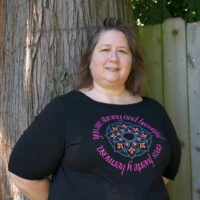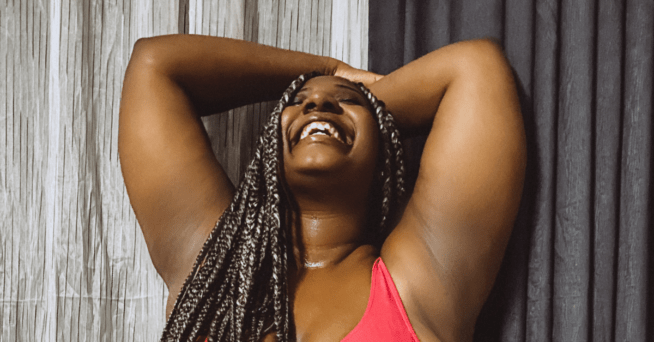We were near the end of an early morning yoga class when the instructor cued us to move into bow pose. I moved onto my stomach and tried to grab my ankles so that I could draw them towards my shoulder blades.
I looked around and realized that everyone in the class had easily moved into the pose — except for me.
I immediately started criticizing myself in my head. “You’re not flexible enough,” I chastised myself. “Your butt is probably too big for this.”
Seeing I was struggling the male instructor came to assist me. He kneeled by my legs, using his thighs to push my legs toward my shoulders, and pulled hard on my arms.
I felt a stabbing pain in my back as he whispered, “Bend your back towards me, your spine has to be completely rounded in this position. Like a bow.”
That’s when it hit me: the problem wasn’t flexibility or my size. The problem was that my upper back can’t bend, because my vertebrae are fused.
It was the first time in thirty years that I thought I truly acknowledged the mobility challenges associated with my Harrington Rods.
I was twelve when I first started having significant back pain. My back hurt every day. I would wake up at night with my muscles seizing and a sensation like my spine was jammed up.
After complaining about it for a solid year, my mom finally took me to the doctor. He came in, took one look at me, and said in a disapproving tone, “Young lady, your back hurts because you’re fat. Stop eating cookies and go get some exercise, and your back will be fine.”
He didn’t even examine me, just made a diagnosis based on my size. I was devastated. I knew my pain was real, but no one else believed me. It was my first lesson on how isolating and demoralizing chronic pain can be.
A year later visiting nurses came to my school to do a screening day. They tested weighed and measured us, tested our hearing, and did a scoliosis screening.
As I bent down to touch my toes, I heard the nurse call her colleague over. “Look at this,” she said. I felt warm fingers trail up my naked spine. “This might be one of the worst cases I’ve seen.”
Scoliosis is a curvature of the spine. Most of the time it is idiopathic, meaning they don’t know what caused it. Scoliosis is highly correlated with being female and tends to occur during adolescence.
The nurses referred me to a specialist and I soon learned that I had severe scoliosis, a curvature of the spine. In my case, the spine had curved so much to one side that my lung wasn’t inflating fully. The only option was spinal fusion surgery.
That school scoliosis screening saved me from serious lung disease and other serious complications.
In spinal fusion surgery, my twisted thoracic vertebrae were sawed apart, then my spine was straightened out and rebuilt with bone from my hip. Two steel rods, called Harrington Rods, were placed on either side of my spine, and connected to the vertebrae with a series of hooks, wires, and screws.
Eventually, the vertebrae would fuse to the hardware in this new straight position.
It took a grueling 12-hour surgery, a long painful recovery, and nearly a year in an uncomfortable heavy plastic brace before I was “healed”. The doctor warned me about reducing the impact to my spine through things like karate or skydiving, but I was told I could otherwise live a “normal” life.
What I didn’t know at the time was that I would be in pain every single day for the rest of my life.
I’m sure the pain is better than it would have been if I had I never had the surgery, and yet it’s still there. The lack of movement in my upper spine causes extra pressure on my lower spine.
I have not slept more than four consecutive hours since 1981, because if I don’t move periodically my back will seize up. I often have a generalized aching in my upper spine.
As I have gotten older, calcification has occurred in the fused vertebrae, making them more prone to pain, and causing issues with my hips and legs.
The difficult thing about chronic pain is that, just like my spinal fusion, no one else can see it. My disability is invisible, yet it’s with me every day.
Over the years I’ve learned ways to manage the pain and work around the mobility challenges; I know that concentrated focus on these two goals help the additional impacts of aging on my condition.
I practice yoga almost daily, with a focus on lengthening and stretching my spine.
I get monthly chiropractic adjustments on my neck and lower spine, to reduce pressure and keep movement in the non-fused vertebrae.
I try not to sit in one place for too long. I use a combination of breathwork, visualization, herbs, and medication for the pain.
I have also learned to recognize the signals that “big pain” is coming, so I can stay ahead of it as much as possible.
Until that day in yoga class though, some part of me always thought if I tried hard enough, I could do whatever I wanted with my body. The day I realized that no amount of trying would help me get into bow pose is the day I accepted that my body was different.
Suddenly a lot of things made sense: why I had a hard time with various yoga poses, the way I could not move my body like everyone else when I took belly dancing class, the way my shoes wear out unevenly.
A couple of years ago I became a yoga teacher, specializing in yoga for people who are non-traditional students: people with larger bodies, people with disabilities, older people, people with back conditions like mine.
As I moved through the practical parts of my training, I began to realize that almost everyone has some issue they are living with. Some students have chronic pain like me. Some have had joint replacements, anxiety, arthritis, vertigo.
One day I taught a private yoga class to someone whose lower spine was fused, so as we moved through our practice, we compared notes on the ramifications of upper spine fusion versus lower spine fusion.
Accepting my condition instead of fighting it has made a huge difference, and it’s made me feel a lot better about myself and the limitations of my body.
Now I work with my body, instead of fighting against it — and that makes everything easier.
 Rose Bak is a freelance writer, author and yoga teacher who lives in Portland, Oregon with her family and special needs dogs. As a dedicated multipotentialite, she writes on a variety of topics including self-care, aging, inspiration, business, and pop culture. She is also a published author of romantic fiction. In addition to writing, she teaches accessible yoga and sings. Sadly, she has absolutely no musical talent so she’s forced to mostly sing in the shower. For more of Rose’s work, visit her website at rosebakenterprises.com or follow her on social media @AuthorRoseBak.
Rose Bak is a freelance writer, author and yoga teacher who lives in Portland, Oregon with her family and special needs dogs. As a dedicated multipotentialite, she writes on a variety of topics including self-care, aging, inspiration, business, and pop culture. She is also a published author of romantic fiction. In addition to writing, she teaches accessible yoga and sings. Sadly, she has absolutely no musical talent so she’s forced to mostly sing in the shower. For more of Rose’s work, visit her website at rosebakenterprises.com or follow her on social media @AuthorRoseBak.
Image courtesy of Jennifer Enujiugha.












